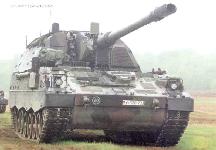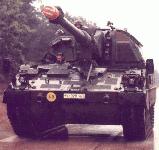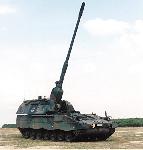PzH 2000 (Panzerhaubitze 2000)
The German PzH 2000 (Panzerhaubitze 2000) is Germany's next generation 155-millimeter self-propelled howitzer, and is among the most capable howitzers. The required range of 30 km with standard NATO- ammunition or almost 40 km with assisted ammunition is achieved by the newly developed 52 cal. 155 mm armament, and also by the new Modular Charge System (MTLS). Continued use of the in-service bag charges is also possible. The 155mm armament is automatically laid at high speed and precision, its position is checked after every fired round and, if necessary, it is relayed automatically. The automatic shell loading system includes different semi- automatic and manual back-up modes, an automatic primer magazine, and automatic inductive fuze setting. A hybrid Global Positioning System [GPS] navigation system is used for navigating and determining the position of the gun barrel. An on-board ballistic computer with a radio data link to an external fire control command post enables the gun to conduct fire missions quickly and independently from any unprepared firing position after receiving target position and ammunition data. The PzH 2000 is also able to automatically lay its main armament in accordance with laying and ammunition data radio transmitted by a fire control command post The PzH 2000 155mm self propelled howitzer was developed by Krauss Maffei - Wegmann and Co GmbH for the German Army. In 1986 Italy, the United Kingdom, and Germany, agreed to terminate the trilateral cooperation on the PzH 155-1 (SP 70) program, and German industry was asked to submit bid proposals for PzH 155 mm (front-driven). Wegmann received a contract in March 1996 for production of 185 units [out of an eventual total of 594] with deliveries between 1998 and 2002 for use in the "crisis reaction forces" (KRK) as well as for first deployment in the Main Forces. Wegmann & Co GmbH, Kassel and Krauss-Maffei Wehrtechnik GmbH, Munich, the two key players on the German and international market for military land vehicles on tracks and wheels have merged in 1998.Wegmann anticipates that there is an international market as ageing US-developed M109s, towed howitzers, and former Eastern bloc equipments requires replacement. NATO standardization requirements as well as the Joint Ballistic Memorandum of Understanding endorsed by France, Germany, Italy, United Kingdom and the United States are met, which ensures interoperability of the PzH 2000 and the interchangeability of ammunition. It is the objective of Wegmann“s international marketing efforts to interest additional allied and friendly armies in the PzH 2000 with the intention of introducing and procuring this weapon system jointly with the German artillery. A larger procurement quantity will result in a lower unit price in Germany as well as a more attractive competitive price on the world market.
The PzH 2000 is an improvement over the US Paladin, but it does not meet all of the American Crusader's requirements. The PzH 2000 is configured as a typical howitzer, with the majority of the crew located in the weapons compartment [the Crusader vehicles have separate crew and weapons compartments, which allows additional armor to be placed around the crew compartment and provides better protection from hits in the weapons compartment]. PzH 2000 contractor officials have said that they could develop an automated resupply vehicle based on the PzH 2000 chassis and modify the PzH 2000 howitzer to meet all of the Crusader key requirements and many of the other Crusader requirements. A modified PzH 2000 howitzer and an automated PzH 2000-based resupply vehicle each would require a crew of three--the same crew size as the Crusader vehicles are expected to require. However, a modified PzH 2000 howitzer would still have crew located in the weapons compartment and the associated adverse impact on survivability.Specifications | |
| Country of origin | Germany |
| Crew | 3+2 (3 men sufficient for operation) |
| Weight | < 55 tons / MLC 60 tons |
| Length | 11.669 m (overall) 7.920 m (hull) |
| Width | 3.58 m |
| Heigth | 3.06 m (turret roof) |
| Clearance | 0.44m |
| Armament | |
| Ammunition | 60 shells, 288 uni-charge modules or equivalent bag charges |
| Resupply | 60 complete rounds by 2 crew members in less than 10 minutes 50 seconds |
| Elevation | -2.5° to +65°; n x 360° |
| Maximum Range | |
| Rate of Fire |
|
| Rearm time | less than 11 minutes |
| Engine | 736 KW - power pack V8 diesel |
| Power to weight ratio | 13.4 KW / t |
| Transmission | Automatic |
| Suspension | torsion bar and shock absorbers |
| Traction | Caterpillars |
| Speed |
|
| Cruising range | > 420 km |
| Maximum gradient | 50% |
| Fording ability | 1.5 m |
| Crossing of ditches | 3 ms |
| Vertical obstacle | 1 m |







